Question Number 60854 by Askash last updated on 26/May/19
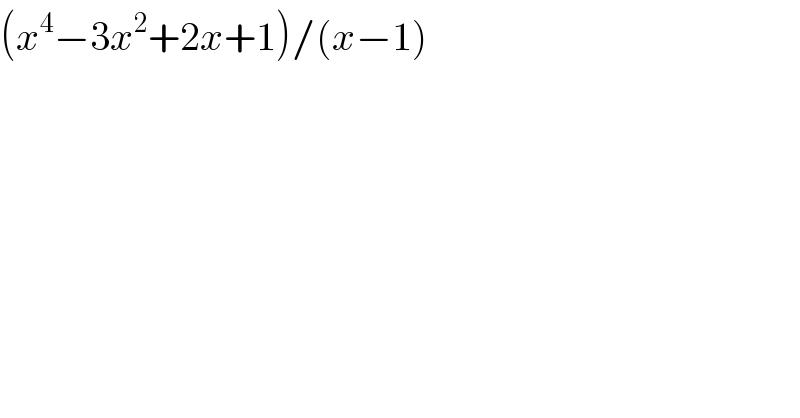
$$\left({x}^{\mathrm{4}} −\mathrm{3}{x}^{\mathrm{2}} +\mathrm{2}{x}+\mathrm{1}\right)/\left({x}−\mathrm{1}\right) \\ $$$$ \\ $$$$ \\ $$
Commented by Askash last updated on 26/May/19

$${i}\:{want}\:{the}\:{best}\:{method}. \\ $$
Commented by maxmathsup by imad last updated on 26/May/19
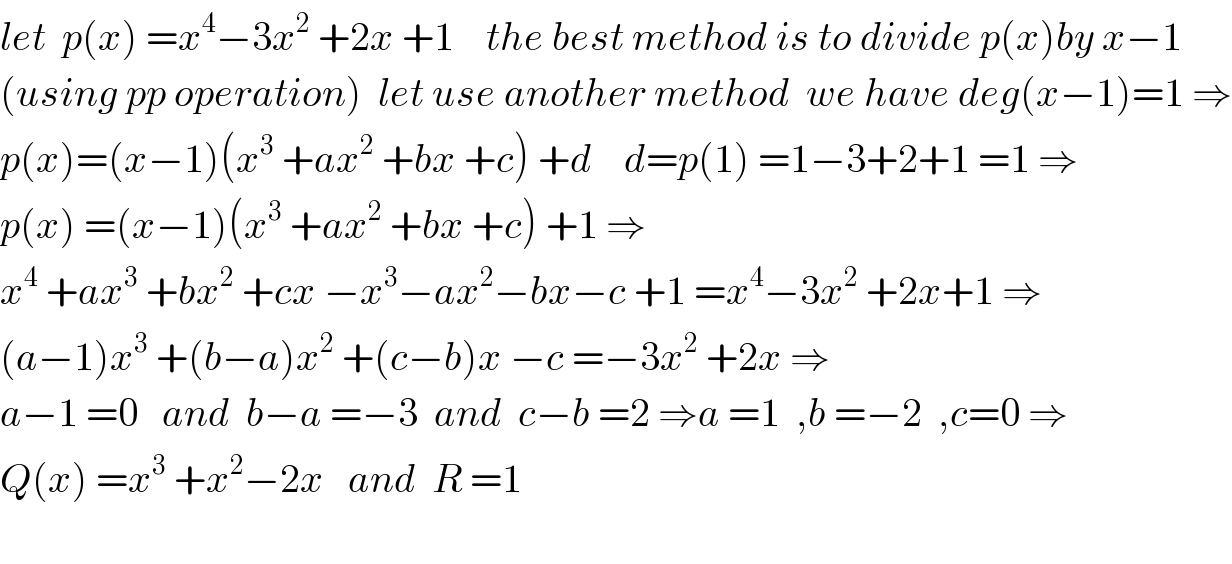
$${let}\:\:{p}\left({x}\right)\:={x}^{\mathrm{4}} −\mathrm{3}{x}^{\mathrm{2}} \:+\mathrm{2}{x}\:+\mathrm{1}\:\:\:\:{the}\:{best}\:{method}\:{is}\:{to}\:{divide}\:{p}\left({x}\right){by}\:{x}−\mathrm{1} \\ $$$$\left({using}\:{pp}\:{operation}\right)\:\:{let}\:{use}\:{another}\:{method}\:\:{we}\:{have}\:{deg}\left({x}−\mathrm{1}\right)=\mathrm{1}\:\Rightarrow \\ $$$${p}\left({x}\right)=\left({x}−\mathrm{1}\right)\left({x}^{\mathrm{3}} \:+{ax}^{\mathrm{2}} \:+{bx}\:+{c}\right)\:+{d}\:\:\:\:{d}={p}\left(\mathrm{1}\right)\:=\mathrm{1}−\mathrm{3}+\mathrm{2}+\mathrm{1}\:=\mathrm{1}\:\Rightarrow \\ $$$${p}\left({x}\right)\:=\left({x}−\mathrm{1}\right)\left({x}^{\mathrm{3}} \:+{ax}^{\mathrm{2}} \:+{bx}\:+{c}\right)\:+\mathrm{1}\:\Rightarrow \\ $$$${x}^{\mathrm{4}} \:+{ax}^{\mathrm{3}} \:+{bx}^{\mathrm{2}} \:+{cx}\:−{x}^{\mathrm{3}} −{ax}^{\mathrm{2}} −{bx}−{c}\:+\mathrm{1}\:={x}^{\mathrm{4}} −\mathrm{3}{x}^{\mathrm{2}} \:+\mathrm{2}{x}+\mathrm{1}\:\Rightarrow \\ $$$$\left({a}−\mathrm{1}\right){x}^{\mathrm{3}} \:+\left({b}−{a}\right){x}^{\mathrm{2}} \:+\left({c}−{b}\right){x}\:−{c}\:=−\mathrm{3}{x}^{\mathrm{2}} \:+\mathrm{2}{x}\:\Rightarrow \\ $$$${a}−\mathrm{1}\:=\mathrm{0}\:\:\:{and}\:\:{b}−{a}\:=−\mathrm{3}\:\:{and}\:\:{c}−{b}\:=\mathrm{2}\:\Rightarrow{a}\:=\mathrm{1}\:\:,{b}\:=−\mathrm{2}\:\:,{c}=\mathrm{0}\:\Rightarrow \\ $$$${Q}\left({x}\right)\:={x}^{\mathrm{3}} \:+{x}^{\mathrm{2}} −\mathrm{2}{x}\:\:\:{and}\:\:{R}\:=\mathrm{1} \\ $$$$ \\ $$
Commented by Tawa1 last updated on 26/May/19
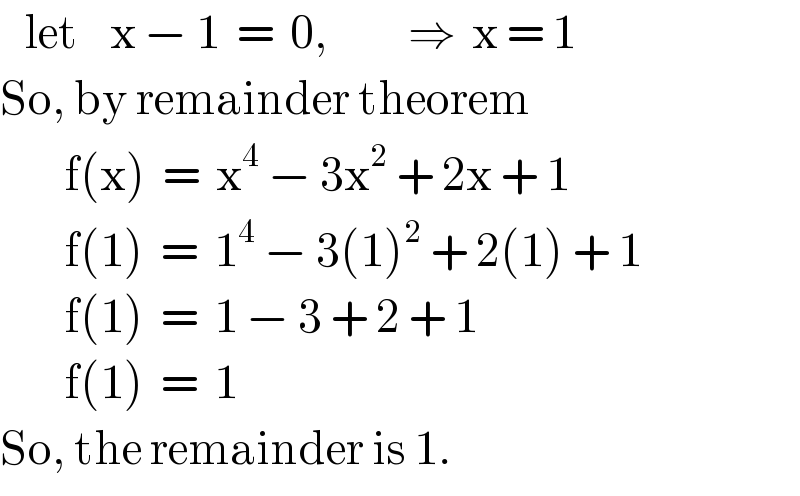
$$\:\:\:\mathrm{let}\:\:\:\:\mathrm{x}\:−\:\mathrm{1}\:\:=\:\:\mathrm{0},\:\:\:\:\:\:\:\:\:\:\Rightarrow\:\:\mathrm{x}\:=\:\mathrm{1}\:\:\:\: \\ $$$$\mathrm{So},\:\mathrm{by}\:\mathrm{remainder}\:\mathrm{theorem} \\ $$$$\:\:\:\:\:\:\:\:\mathrm{f}\left(\mathrm{x}\right)\:\:=\:\:\mathrm{x}^{\mathrm{4}} \:−\:\mathrm{3x}^{\mathrm{2}} \:+\:\mathrm{2x}\:+\:\mathrm{1} \\ $$$$\:\:\:\:\:\:\:\:\mathrm{f}\left(\mathrm{1}\right)\:\:=\:\:\mathrm{1}^{\mathrm{4}} \:−\:\mathrm{3}\left(\mathrm{1}\right)^{\mathrm{2}} \:+\:\mathrm{2}\left(\mathrm{1}\right)\:+\:\mathrm{1} \\ $$$$\:\:\:\:\:\:\:\:\mathrm{f}\left(\mathrm{1}\right)\:\:=\:\:\mathrm{1}\:−\:\mathrm{3}\:+\:\mathrm{2}\:+\:\mathrm{1} \\ $$$$\:\:\:\:\:\:\:\:\mathrm{f}\left(\mathrm{1}\right)\:\:=\:\:\mathrm{1} \\ $$$$\mathrm{So},\:\mathrm{the}\:\mathrm{remainder}\:\mathrm{is}\:\mathrm{1}. \\ $$
Commented by Askash last updated on 26/May/19

$${any}\:{easy}\:{to}\:{find}\:{remainder} \\ $$
Answered by ajfour last updated on 26/May/19
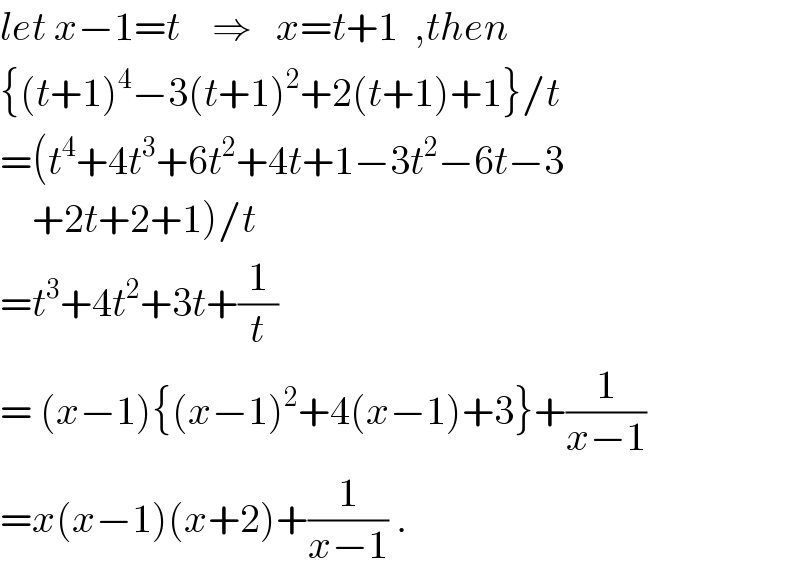
$${let}\:{x}−\mathrm{1}={t}\:\:\:\:\Rightarrow\:\:\:{x}={t}+\mathrm{1}\:\:,{then} \\ $$$$\left\{\left({t}+\mathrm{1}\right)^{\mathrm{4}} −\mathrm{3}\left({t}+\mathrm{1}\right)^{\mathrm{2}} +\mathrm{2}\left({t}+\mathrm{1}\right)+\mathrm{1}\right\}/{t} \\ $$$$=\left({t}^{\mathrm{4}} +\mathrm{4}{t}^{\mathrm{3}} +\mathrm{6}{t}^{\mathrm{2}} +\mathrm{4}{t}+\mathrm{1}−\mathrm{3}{t}^{\mathrm{2}} −\mathrm{6}{t}−\mathrm{3}\right. \\ $$$$\left.\:\:\:\:+\mathrm{2}{t}+\mathrm{2}+\mathrm{1}\right)/{t} \\ $$$$={t}^{\mathrm{3}} +\mathrm{4}{t}^{\mathrm{2}} +\mathrm{3}{t}+\frac{\mathrm{1}}{{t}} \\ $$$$=\:\left({x}−\mathrm{1}\right)\left\{\left({x}−\mathrm{1}\right)^{\mathrm{2}} +\mathrm{4}\left({x}−\mathrm{1}\right)+\mathrm{3}\right\}+\frac{\mathrm{1}}{{x}−\mathrm{1}} \\ $$$$={x}\left({x}−\mathrm{1}\right)\left({x}+\mathrm{2}\right)+\frac{\mathrm{1}}{{x}−\mathrm{1}}\:. \\ $$
Answered by Rasheed.Sindhi last updated on 26/May/19
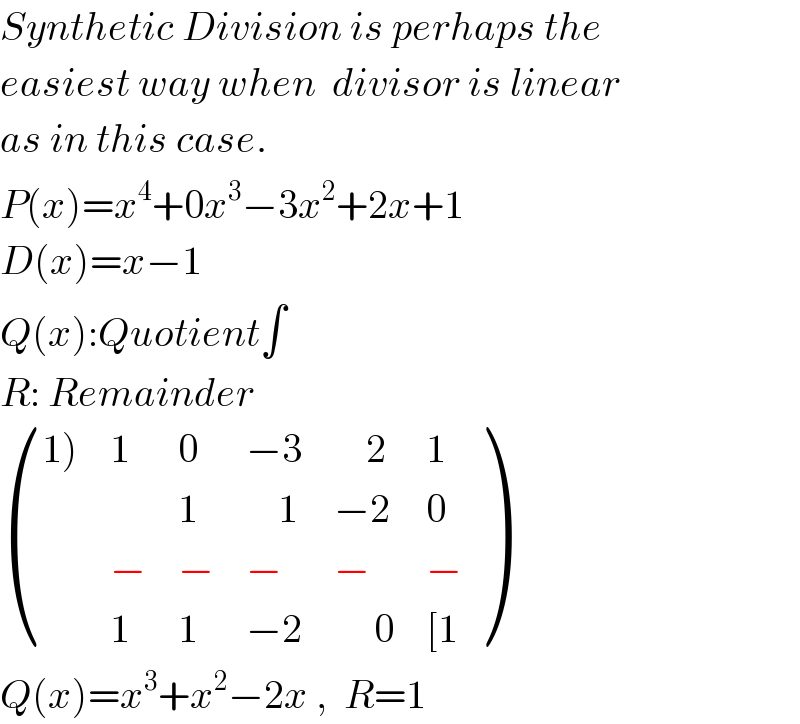
$${Synthetic}\:{Division}\:{is}\:{perhaps}\:{the} \\ $$$${easiest}\:{way}\:{when}\:\:{divisor}\:{is}\:{linear} \\ $$$${as}\:{in}\:{this}\:{case}. \\ $$$${P}\left({x}\right)={x}^{\mathrm{4}} +\mathrm{0}{x}^{\mathrm{3}} −\mathrm{3}{x}^{\mathrm{2}} +\mathrm{2}{x}+\mathrm{1} \\ $$$${D}\left({x}\right)={x}−\mathrm{1} \\ $$$${Q}\left({x}\right):{Quotient}\int \\ $$$${R}:\:{Remainder} \\ $$$$\begin{pmatrix}{\left.\mathrm{1}\right)}&{\mathrm{1}}&{\mathrm{0}}&{−\mathrm{3}}&{\:\:\:\:\mathrm{2}}&{\mathrm{1}}\\{}&{}&{\mathrm{1}}&{\:\:\:\:\mathrm{1}}&{−\mathrm{2}}&{\mathrm{0}}\\{}&{−}&{−}&{−}&{−}&{−}\\{}&{\mathrm{1}}&{\mathrm{1}}&{−\mathrm{2}}&{\:\:\:\:\:\mathrm{0}}&{\left[\mathrm{1}\right.}\end{pmatrix} \\ $$$${Q}\left({x}\right)={x}^{\mathrm{3}} +{x}^{\mathrm{2}} −\mathrm{2}{x}\:,\:\:{R}=\mathrm{1} \\ $$
Commented by malwaan last updated on 26/May/19

$${yes}\:{mr}\:{Rasheed} \\ $$$${fast}\:{and}\:{easy} \\ $$$${thank}\:{you} \\ $$
Commented by Rasheed.Sindhi last updated on 27/May/19

$${You}'{re}\:{welcome}\:{sir}! \\ $$
Commented by Rasheed.Sindhi last updated on 27/May/19

$${This}\:{is}\:{also}\:{an}\:{easy}\:{way}\:{to}\:{evaluate} \\ $$$${polynomial}\:{P}\left({x}\right)\:{at}\:{x}={a}\:{i}-{e}\:{P}\left({a}\right). \\ $$
